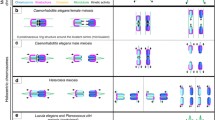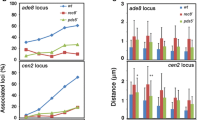Abstract
Chromosome segregation ensures the equal partitioning of chromosomes at mitosis. However, long chromosome arms may pose a problem for complete sister chromatid separation. In this paper we report on the analysis of cell division in primary cells from field vole Microtus agrestis, a species with 52 chromosomes including two giant sex chromosomes. Dual chromosome painting with probes specific for the X and the Y chromosomes showed that these long chromosomes are prone to mis-segregate, producing DNA bridges between daughter nuclei and micronuclei. Analysis of mitotic cells with incomplete chromatid separation showed that reassembly of the nuclear membrane, deposition of INner CENtromere Protein (INCENP)/Aurora B to the spindle midzone and furrow formation occur while the two groups of daughter chromosomes are still connected by sex chromosome arms. Late cytokinetic processes are not efficiently inhibited by the incomplete segregation as in a significant number of cell divisions cytoplasmic abscission proceeds while Aurora B is at the midbody. Live-cell imaging during late mitotic stages also revealed abnormal cell division with persistent sister chromatid connections. We conclude that late mitotic regulatory events do not monitor incomplete sister chromatid separation of the large X and Y chromosomes of Microtus agrestis, leading to defective segregation of these chromosomes. These findings suggest a limit in chromosome arm length for efficient chromosome transmission through mitosis.







Similar content being viewed by others
References
Adams RR, Wheatley SP, Gouldsworthy AM, Kandels-Lewis SE, Carmena M, Smythe C, Gerloff DL, Earnshaw WC (2000) INCENP binds the Aurora-related kinase AIRK2 and is required to target it to chromosomes, the central spindle and cleavage furrow. Curr Biol 10:1075–1078
Croft JA, Bridger JM, Boyle S, Perry P, Teague P, Bickmore WA (1999) Differences in the localization and morphology of chromosomes in the human nucleus. J Cell Biol 145:1119–1131
Eckley DM, Ainsztein AM, Mackay AM, Goldberg IG, Earnshaw WC (1997) Chromosomal proteins and cytokinesis: patterns of cleavage furrow formation and inner centromere protein positioning in mitotic heterokaryons and mid-anaphase cells. J Cell Biol 136:1169–1183
Funabiki H, Kumada K, Yanagida M (1996) Fission yeast Cut1 and Cut2 are essential for sister chromatid separation, concentrate along the metaphase spindle and form large complexes. EMBO J 15:6617–6628
Hudakova S, Kunzel G, Endo TR, Schubert I (2002) Barley chromosome arms longer than half of the spindle axis interfere with nuclear divisions. Cytogenet Genome Res 98:101–107
Kalscheuer V, Singh AP, Nanda I, Sperling K, Neitzel H (1996) Evolution of the gonosomal heterochromatin of Microtus agrestis: rapid amplification of a large, multimeric, repeat unit containing a 3.0-kb (GATA)11-positive, middle repetitive element. Cytogenet Cell Genet 73:171–178
Kanda T, Sullivan KF, Wahl GM (1998) Histone-GFP fusion protein enables sensitive analysis of chromosome dynamics in living mammalian cells. Curr Biol 8:377–385
Kumada K, Yao R, Kawaguchi T, Karasawa M, Hoshikawa Y, Ichikawa K, Sugitani Y, Imoto I, Inazawa J, Sugawara M, Yanagida M, Noda T (2006) The selective continued linkage of centromeres from mitosis to interphase in the absence of mammalian separase. J Cell Biol 172:835–846
Marchal JA, Acosta MJ, Nietzel H, Sperling K, Bullejos M, Diaz de la Guardia R, Sanchez A (2004) X chromosome painting in Microtus: origin and evolution of the giant sex chromosomes. Chromosome Res 12:767–776
Moir RD, Yoon M, Khuon S, Goldman RD (2000) Nuclear lamins A and B1: different pathways of assembly during nuclear envelope formation in living cells. J Cell Biol 151:1155–1168
Morgan DO (1999) Regulation of the APC and the exit from mitosis. Nat Cell Biol 1:E47–E53
Neitzel H, Kalscheuer V, Henschel S, Digweed M, Sperling K (1998) Beta-heterochromatin in mammals: evidence from studies in Microtus agrestis based on the extensive accumulation of L1 and non-L1 retroposons in the heterochromatin. Cytogenet Cell Genet 80:165–172
Neitzel H, Kalscheuer V, Singh AP, Henschel S, Sperling K (2002) Copy and paste: the impact of a new non-L1 retroposon on the gonosomal heterochromatin of Microtus agrestis. Cytogenet Genome Res 96:179–185
Norden C, Mendoza M, Dobbelaere J, Kotwaliwale CV, Biggins S, Barral Y (2006) The NoCut pathway links completion of cytokinesis to spindle midzone function to prevent chromosome breakage. Cell 125:85–98
Pereira G, Schiebel E (2003) Separase regulates INCENP-Aurora B anaphase spindle function through Cdc14. Science 302:2120–2124
Rens W, O’Brien PC, Yang F, Graves JA, Ferguson-Smith MA (1999) Karyotype relationships between four distantly related marsupials revealed by reciprocal chromosome painting. Chromosome Res 7:461–474
Rens W, O’Brien PC, Fairclough H, Harman L, Graves JA, Ferguson-Smith MA (2003a) Reversal and convergence in marsupial chromosome evolution. Cytogenet Genome Res 102:282–290
Rens W, O’Brien PC, Graves JA, Ferguson-Smith MA (2003b) Localization of chromosome regions in potoroo nuclei (Potorous tridactylus Marsupialia: Potoroinae). Chromosoma 112:66–76
Schubert I, Oud JL (1997) There is an upper limit of chromosome size for normal development of an organism. Cell 88:515–520
Singh A, Henschel S, Sperling K, Kalscheuer V, Neitzel H (2000) Differences in the meiotic pairing behavior of gonosomal heterochromatin between female and male Microtus agrestis: implications for the mechanism of heterochromatin amplification on the X and Y. Cytogenet Cell Genet 91:253–260
Uhlmann F (2004) The mechanism of sister chromatid cohesion. Exp Cell Res 296:80–85
Vagnarelli P, Earnshaw WC (2004) Chromosomal passengers: the four-dimensional regulation of mitotic events. Chromosoma 113:211–222
Veldman T, Etheridge KT, Counter CM (2004) Loss of hPot1 function leads to telomere instability and a cut-like phenotype. Curr Biol 14:2264–2270
Walen KH, Brown SW (1962) Chromosomes in a marsupial (Potorous tridactylis) tissue culture. Nature 194:406
Wirth KG, Wutz G, Kudo NR, Desdouets C, Zetterberg A, Taghybeeglu S, Seznec J, Ducos GM, Ricci R, Firnberg N, Peters JM, Nasmyth K (2006) Separase: a universal trigger for sister chromatid disjunction but not chromosome cycle progression. J Cell Biol 172:847–860
Yalon M, Gal S, Segev Y, Selig S, Skorecki KL (2004) Sister chromatid separation at human telomeric regions. J Cell Sci 117:1961–1970
Yanagida M (2000) Cell cycle mechanisms of sister chromatid separation; roles of Cut1/separin and Cut2/securin. Genes Cells 5:1–8
Zou H, McGarry TJ, Bernal T, Kirschner MW (1999) Identification of a vertebrate sister-chromatid separation inhibitor involved in transformation and tumorigenesis. Science 285:418–422
Zur A, Brandeis M (2001) Securin degradation is mediated by fzy and fzr, and is required for complete chromatid separation but not for cytokinesis. EMBO J 20:792–801
Acknowledgements
This work was performed at the Cambridge Resource Centre for Comparative Genomics and was supported by a grant from the Wellcome Trust to MAFS.
Microtus agrestis X- and Y-chromosome-specific DNA was kindly provided by Dr. F. Yang. The inner centromere protein (INCENP) antibody was kindly provided by Prof. WC Earnshaw. A Microtus agrestis specimen was supplied by the house cat Tipper.
Author information
Authors and Affiliations
Corresponding author
Additional information
Communicated by F. Uhlmann
Electronic supplemental material
Supplementary movie 1, 2, and 3 show Microtus agrestis cell division. The chromosomes were visualized using HistoneH2B-GFP. Movie 1 shows a normal cell division in 10 min total time. Movie 2 and 3 show a division where the two daughter nuclei are connected by a thread of DNA. Movie 2 is taken in 86 frames collected at 16 sec time intervals (23 min total time). Movie 3 shows a cell division that lasts 20 minutes. The first 6 frames were collected at 30 sec intervals. The next 18 frames were collected at one minute intervals (total 20 min, 24 frames). These two daughter cells were observed for another 20 minutes at irregular time intervals, but no further significant movement was observed.
Rights and permissions
About this article
Cite this article
Rens, W., Torosantucci, L., Degrassi, F. et al. Incomplete sister chromatid separation of long chromosome arms. Chromosoma 115, 481–490 (2006). https://doi.org/10.1007/s00412-006-0077-1
Received:
Revised:
Accepted:
Published:
Issue Date:
DOI: https://doi.org/10.1007/s00412-006-0077-1




